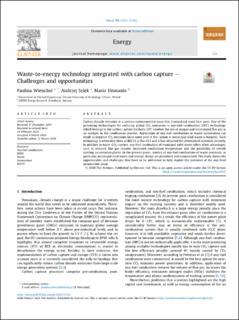| dc.contributor.author | Wienchol, Paulina | |
| dc.contributor.author | Szlek, Andrzej | |
| dc.contributor.author | Ditaranto, Mario | |
| dc.date.accessioned | 2020-06-25T12:29:29Z | |
| dc.date.available | 2020-06-25T12:29:29Z | |
| dc.date.created | 2020-03-18T14:46:19Z | |
| dc.date.issued | 2020 | |
| dc.identifier.issn | 0360-5442 | |
| dc.identifier.uri | https://hdl.handle.net/11250/2659562 | |
| dc.description.abstract | Carbon dioxide emission is a serious environmental issue that humankind must face soon. One of the promising technologies for reducing global CO2 emissions is oxy-fuel combustion (OFC) technology, which belongs to the carbon capture methods. OFC involves the use of oxygen and recirculated flue gas as an oxidizer in the combustion process. Application of oxy-fuel combustion in waste incineration can result in negative CO2 emission since some part of the carbon in municipal solid waste is biogenic. Such technology is often described as BECCS or Bio-CCS and it has attracted the attention of scientists recently. In addition to easier CO2 capture, oxy-fuel combustion of municipal solid waste offers other advantages, such as reduced flue gas volume, increased combustion temperature and the possibility of retrofit existing incineration plants. In the present paper, studies of oxy-fuel combustion of waste materials, in particular, municipal solid waste and sewage sludge are presented and summarized. The study shows the opportunities and challenges that have to be addressed to fully exploit the potential of the oxy-fired incineration plant. | en_US |
| dc.language.iso | eng | en_US |
| dc.publisher | Elsevier | en_US |
| dc.rights | Navngivelse 4.0 Internasjonal | * |
| dc.rights.uri | http://creativecommons.org/licenses/by/4.0/deed.no | * |
| dc.title | Waste-to-energy technology integrated with carbon capture – Challenges and opportunities | en_US |
| dc.type | Peer reviewed | en_US |
| dc.type | Journal article | en_US |
| dc.description.version | publishedVersion | en_US |
| dc.rights.holder | The Authors | en_US |
| dc.source.pagenumber | 117352 | en_US |
| dc.source.volume | 198 | en_US |
| dc.source.journal | Energy | en_US |
| dc.identifier.doi | 10.1016/j.energy.2020.117352 | |
| dc.identifier.cristin | 1802256 | |
| dc.relation.project | Norges forskningsråd: 281869 | en_US |
| dc.relation.project | Norges forskningsråd: 299683 | en_US |
| cristin.ispublished | true | |
| cristin.fulltext | original | |
| cristin.qualitycode | 2 | |

